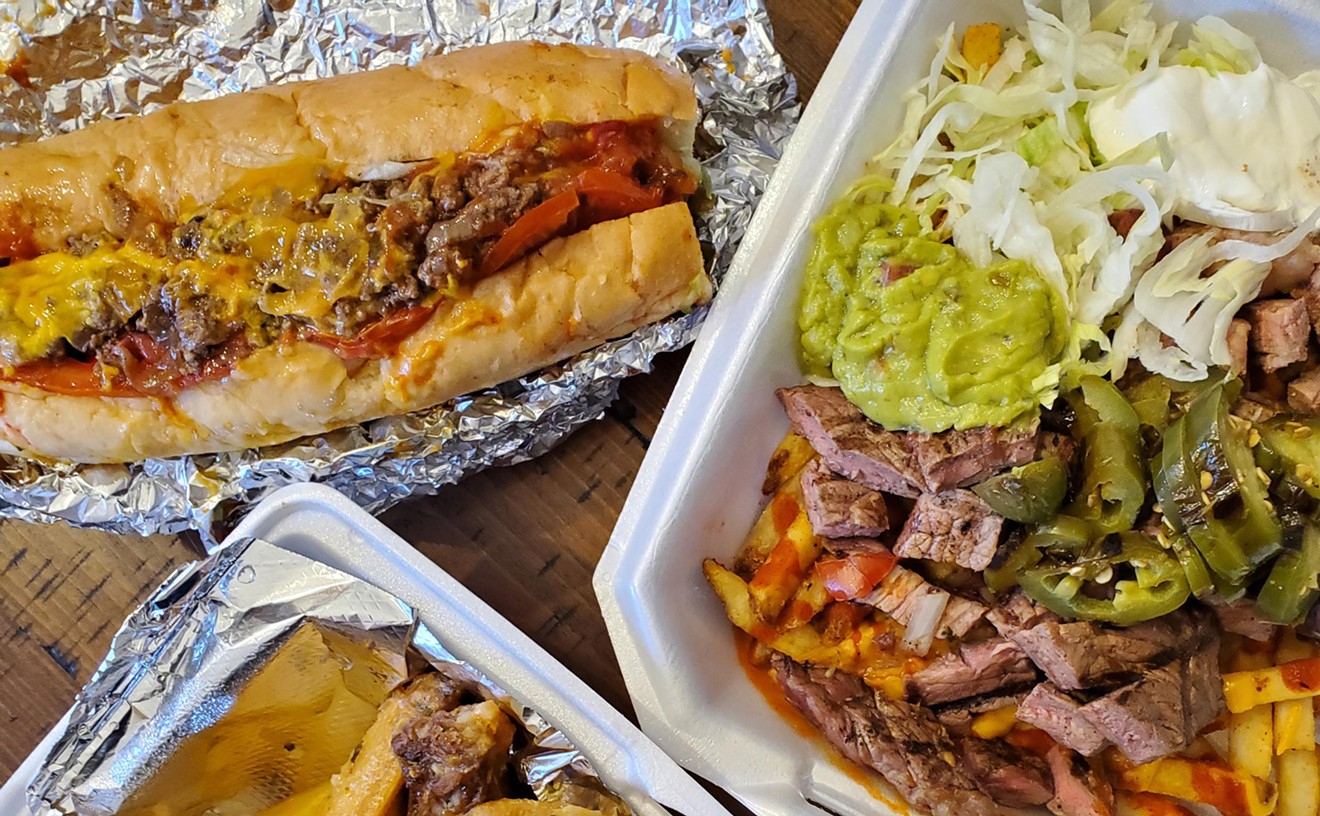In the food world, a war has long been waged over what, exactly, it is that cooks and chefs produce. In the galleys and the prep kitchens, on the hot lines and in the bars after work, there have been discussions, arguments, names called, the occasional punch thrown; outside this insular environment, there have been panel discussions, articles (written both by windy academics who consistently get it wrong and by former cooks who get it right but are most often ignored), entire books about the secret fight for the heart and the soul of American cuisine.
On one side are the gentle, delicate souls, usually school-trained, who feel more than know that a chef is an artist, the plate his canvas, his aim the nourishment not just of his customers' bellies, but their brains, as well. Menus designed around smells (smoldering pine needles, Lemon Pledge, that sort of thing), twenty-course degustations, the ridiculous overuse of ylang-ylang, fiddlehead fern, frisée and PVC cut-downs, foods that look like other foods, or foods that don't look like food at all, the wearing of unusual facial hair: These are all trademarks of the artiste at work.
On the other side are the tradesmen — guys who, for the most part, came up the hard way as journeymen and apprentices, bouncing from kitchen to kitchen, picking up their skills a little at a time and often finding their specialty (saucier, poissonarde, mercenary grill man, whatever), through blind luck. The tradesmen understand that they are like plumbers, like bricklayers, like carpenters — that they have work to do for which they are uniquely trained and qualified, and that doing it well and without complaint is their primary responsibility. They know that just doing the job and feeding the people is noble enough; that education, enlightenment, spiritual revelation, transcendence and funny-looking lettuces are none of their business and should be left to schools, churches, Gourmet magazine and the Food Network. These are the guys who name their knives like rock stars do their guitars, who wear snap-front dish jackets when they work and only grudgingly pull on the whites to walk the floor, who run their kitchens the way pirate captains do their ships — through a combination of awe, terror and strong drink — and construct their menus around things that real people might actually want to eat: roasted chickens, grilled fish, thick steaks, sauces and sides tested across generations. Their artistic aspirations, if they have any at all, are sublimated, forced out onto the apps board, where the vaguely Asian tuna tartare or sculpture of melon balls with prosciutto will do the least damage.
There is no love lost between these two antagonistic camps. The battle breaks down mostly along semantic lines — in the insults hurled back and forth, the particularly malicious and lovely patois of the professional line. To the artist, the tradesman is a tank commander, a hash-slinger, a shoemaker, some "goddamn Buster Brown motherfucker" laying down his mise for repetitive action, for simple garniture and ease of use. To the tradesman, his opposite number is flighty, flaky, snobbish and slow: an artist. He is Picasso; he is Bob Ross making happy little trees. At a particularly grim point in my own career, when I was still young and dumb and didn't know any better, I was written off at the end of three days' worth of test-cooking as "just another faggot squeeze-bottle artist," shown the door and told to go through it. Quickly.
The battle is nasty — bitterly felt by those on the inside, pretty much discounted by those who aren't — and is likely to be the defining conflict of this culinary generation. And right now, one of the best places to see it being fought en clair is at Kevin Taylor's reinvented Palettes at the reinvented Denver Art Museum.
At first blush, Palettes is one of the coldest, least inviting rooms I've ever had the misfortune of walking into. Everything that isn't white is gray — gray-blue, silver-gray, slate gray — and everything that isn't gray or white is art, which is worse. I don't care much for art, know nothing about it; my idea of a masterpiece is an old oil-on-canvas painting of a sailing ship wracked by storms, a black-and-white photograph by Weegee, Frank Miller, high-class porno or a framed litho of a travel poster from 1930s offering a zeppelin flight from New York to Egypt and back. From our table in the fish-tank side room at Palettes, Laura and I were surrounded by huge canvases streaked with color that looked like the worst job of house-painting ever, and another that looked like monster gummi worms headed south. Seeing these, Laura leaned over and said, "You know what my favorite art in this room is? The exit sign. We should use it now."
But we didn't. Not then and not, as things would turn out, for an achingly long time. The chairs at Palettes are made of gray injection-molded plastic and are probably art in their own right. But that doesn't mitigate the fact that they look like something that ought to be lined up against the wall outside a bus station men's room and are maddeningly uncomfortable to any upright mammal born with a spine. I'd make a joke about the servers being made of gray plastic as well — lifelike but vacant, bound in the house livery of silvery gray, plain gray, white and perfectly creased black — except for the fact that plastic would have stayed in place long enough for me to have gotten its attention after it took twenty minutes to bring drinks and another hour for apps in a room populated by only a half-dozen tables.
When the servers were on the floor at all, they seemed to walk in a fog of their own imaginings, slightly blank-eyed, overwhelmed, perhaps, by the canted architecture, the mind-numbing plainness of the color palette, the downward progress of the gummi worms on the wall. Whenever they arrived at our table, it was as though they'd just been roused from a dream. And even on the main floor — where the banks of windows offer proof that there is a world outside this cosseted bubble of monochrome and ennui, and where the kitchen, seen through the pass, provides a welcome hit of color and action — the dignified quiet was deafening. It made me want to leap to my feet, tie a napkin around my face and, brandishing a lamb-chop pistol, start demanding people's valuables. Or, failing that, take a nap.
Funny thing, though. Once, glacially, the food began to arrive, my entire mood changed. I don't know if this particular magic fell under that same category of effect where anything tastes good to a starving man, and water and Lafite-Rothschild taste the same when you're dying of thirst, but just the color of the food on the table (white plates, white tablecloths, silver silver, a gray menu so subdued that its graphic designer didn't even deign to use capital letters) seemed nourishing to me — a starburst of lively shades, of smells other than air, of shapes that weren't all fierce and angular. And it tasted even better than it looked.
The delicious Anaheim chile relleno was like a hand grenade going off — golden-brown jacket of batter, green chile flesh encasing pure white goat cheese melting out across a deep, brick-red tarn of cinnamon-spiked tomato sauce and a crown of yellow, red and green corn salsa. The black mussels came attended by kaffir lime, razor-sharp serrano chiles, green mint and Thai basil and a tart lemongrass broth. The smoked sweet-corn soup was disturbingly brown, but shot with pale green guacamole and topped with a single red barbecued shrimp. It was spicy and sweet, smooth and chunky at the same time, its flavors and textures and colors all working in balanced counterpoint. But then, Kevin Taylor, who assembled the menu, has been offering varying styles of this soup at varying addresses for years. The only dish I didn't like was the homemade macaroni and cheese with Tillamook cheddar, fontina and parmesan, toasted bread crumbs and wheat pasta.
Dan Gullickson is the chef who handles the day-to-day ops at Palettes (which means lunch seven days a week plus Friday dinner, which is essentially the lunch menu plus a steak, and a lot more expensive), who stands post on the line, sees to the grinding details of daily service while Taylor handles all the big-picture stuff. He's definitely a tradesman chef working in an artist's world. Better, he is a craftsman chef — one who has moved beyond simple repetition, the hanging-and-banging rote work of the mid-range kitchen, and brought the sensibility of the blue-collar cook to the white-on-white world of the fine-dining chef.
In a room like this one, the chef sees no paradox in serving big piles of garlic mashed potatoes, thick sirloin steaks with onion rings and pico de gallo, a wonderful pork schnitzel with roasted fingerlings, cherry tomatoes and a pitch-perfect lemon-caper brown-butter sauce like a piccata, only better. Gullickson can move gracefully from the blithe and nouvelle (a rock-shrimp cocktail, fruit-spiked, served with a sharp jalapeño cocktail sauce) to the classic (portobello mushroom, sliced and juiced with a port wine butter, served beside grilled asparagus) to the über-classic (roasted half-chicken with frites and sauce moutarde) and make it all seem right.
That chicken is a benchmark dish, a hearty bistro presentation that's been done for a hundred years and is the measure of a kitchen's skill — and the Palettes roast chicken was the best I've had all year. Crisp, slightly sticky skin, juicy meat still steaming when I cut into it, a plate both sauced and napped with a lemony coarse-grain mustard sauce barely touched with tarragon and, to the side, a huge, tangled pile of crisp shoestring frites: The dish was perfect, suitable for framing, requiring as much art in its prep and presentation as any hundred tuna tartares, ring-mold salads or squeeze-bottle masterpieces, yet presented plainly, with a craftsman's pride.
Surrounded by art, overwhelmed by silence and eating this ideal chicken, the craft of one great cook and one good kitchen finally made Palettes tolerable, since it had done the simple and traditional extraordinarily well.
But, hey, I'm just another squeeze-bottle reject who wouldn't recognize actual art if it crawled up and humped my leg, so what do I know?










